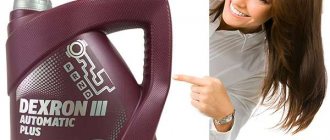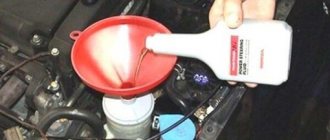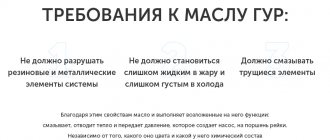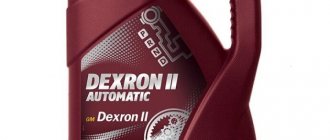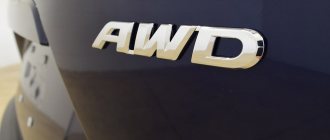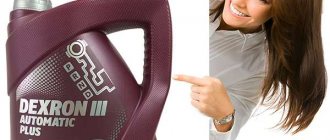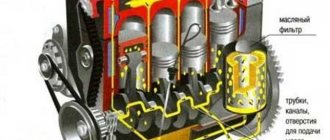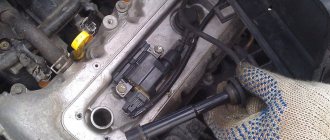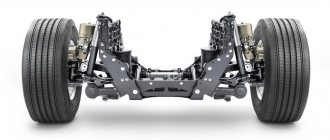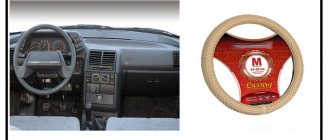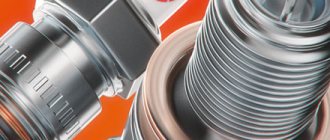Many automakers claim that transmission fluid is filled in for the entire service life of the vehicle, but over time, ATF loses its properties and cannot fully ensure the operation of the box. The choice of oil plays a key role in the further operation of the car, so when replacing, you should take into account the manufacturer’s requirements, checking compliance with specifications and tolerances. The largest automakers often produce their own products to service their cars or, after testing oils from well-known brands, recommend them for use. Generally accepted quality standards ensure the safety of using fluids for various car gearboxes. This information is indicated on the product packaging.
The right Dexron gear oil will protect your transmission.
ATF fluids for automatic transmissions perform many more tasks than ordinary transmission oils. In addition to the function of lubricating parts, they bear full responsibility for the performance of the box. ATF cools, provides frictional clutch, transmits torque, protects against corrosion and premature aging. Gear oils are mostly colored bright red, with the exception of some varieties. They can be mineral or synthetic oil based. Today, Dextron 3 transmission oil is one of the most popular products for automatic transmission maintenance, presented by many manufacturers of automotive special equipment.
For reference
1) There are several known methods of complete replacement:
- “with suction” - through the available openings of the machine (for example, for the dipstick), everything that is possible is pumped out to the maximum, then new ATF is poured in. It’s not labor-intensive, but the bad thing is that at least a fair amount of old fluid remains in the gas turbine housing, and the pan and filter remain uncleaned.
— “flow-through replacement” — after draining the ATF, a stand is connected to the machine (for example, through the ATF cooler hoses) and the box is forcibly washed with fresh liquid. Not bad, but it can’t always be implemented constructively, and the gas turbine engine is still not cleaned.
— “displacement” — through the same stand, with the engine running, fresh fluid is supplied and the old one is drained, in this way the gas turbine engine body can also be washed.
- “sequential replacement” - the old fluid is drained as much as possible, a new one is poured in, mixed while moving, drained again, and so on several times (2-3-..., the more, the better). But, of course, part of the old liquid remains dissolved in the fresh one. The method is expensive and labor-intensive, but reliable. Approximately, for a complete flushing and refueling, on average, an amount of ATF is used that is comparable to two full filling volumes of the automatic transmission.
2) Don't forget to replace the filter. You shouldn’t skimp on this, even if some unscrupulous service providers claim otherwise. Even the simplest “oil receiver” type strainer does not need to be replaced, but needs regular cleaning, washing and checking for damage. And the closed “box” type filter requires (!) replacement at least once every two oil changes (depending on the intensity of accumulation of wear products in each specific box).
What do car enthusiasts think?
Power steering fluid, composition, types and features
Reviews from motorists about the compositions are positive. They confirm the advantages declared by the manufacturer. Products manufactured by General Motors are used mainly by owners of the concern's cars. Dexron VI standard substances are among the most popular on the market. They are used by almost all owners of cars produced in 2006 and later.
The frequency of oil changes is individual for each driver. It depends on the type of driving, the quality of the roads on which you have to travel, the climate of the region and other factors. Those who use the car moderately replace this ATF approximately once every 7 years.
Specifications
You can get acquainted with the characteristics of Sintek Dextron 3 from the table:
| Parameter | Value/Units |
| Kinematic viscosity at 100 °C | 7.41 mm2/s |
| Dynamic viscosity according to Brookfield at -40 °C | 19580 mPa∙s |
| Flash point in open crucible | 195 °C |
| Pour point | – 44 °C |
| Density at 15 °C | 0.8681 g/cm3 |
Interchangeability of Dexron 3 with other lubricants
Replacing the abs sensor: types, types, principles of operation and causes of failure
Is it possible to mix Dextrons from different manufacturers and with different indexes? Let's answer this question briefly.
In automatic transmissions, it is advisable to use only those transmission fluids recommended by the manufacturer. However, on forums and even serious service stations, technicians often recommend cheaper or more accessible analogues.
But such a replacement will not always be correct. For example, it is better not to change Toyota’s specialized Dextron 3 oil, intended for Asian cars, to Mobile Dextron 3 unless there is reliable information about the possibility of such a replacement.
Even with confirmation of certificates from GM, external similarity and similar viscosity. Although the JASO standard for the Japanese automobile industry was created, including on the developments of GM.
For example, if, according to the requirements of the car manufacturer, Dexron 2 series oil must be poured into the box, then you can safely use any version of Dexron 3 lubricants.
The differences between Dextron 2 and 3 in all parameters show improved performance with increasing index. The same goes for Dexron 6 series oils.
It is better not to downgrade the lubricant. This will negatively affect transmission parts within a fairly short period of time.
As for power steering, similar rules apply here. However, you can fill in any other liquid for a short time if it is not possible to purchase a suitable one.
Operating the hydraulic booster dry will have greater negative consequences for the power steering than with unsuitable oil. About the standards of transmission lubricant Dextron 2,3,6 - video
The operating principle of automatic transmission and power steering is based on the operation of fluids, such as ATF Dexron 3. Lubricants from different manufacturers are sold with a similar name. Oils vary in composition, characteristics and performance. Familiarization with the Dextron specification will help you navigate the diversity and choose the best product.
Operating conditions for Dextron transmission fluids
The service life of ATF Dexron depends not only on the mileage, but also on the operating conditions of the machine:
- with aggressive driving, frequent slipping, driving on broken roads, ATF Dexron II and III wear out quickly;
- starting without warming up the automatic transmission oil in winter leads to rapid aging of Dexron 2 and 3;
- due to underfilling of fluid in the box, the pressure drops, the performance properties of the automatic transmission oil are reduced;
- the overflow of ATP causes the emulsion to foam. The excess splashes out, and the automatic transmission becomes underfilled with fluid;
- Constant overheating of the oil above 90℃ leads to loss of performance.
Manufacturers select ATP based on viscosity, load tolerance, friction properties, etc. for reliable operation of the waterworks. The marking for the recommended oil type, for example ATF Dexron II G or ATF Dexron III H, is indicated on the design:
- on automatic transmission oil dipsticks;
- on the plate under the hood;
- on the label of the power steering reservoirs.
The manufacturer's recommendations must be followed. This is what will happen if you ignore the instructions:
- Gears in the automatic transmission will shift with a delay. In newly filled liquid, frictional friction parameters may be underestimated or overestimated. The discs will slip at a different speed. Hence the increased consumption of ATF Dexron and wear of the clutches
- Loss of smoothness of gear shifting in automatic transmission. Changing the proportion and composition of additives leads to improper operation of the oil pump. Pressure will be supplied to the automatic transmission mechanisms with a delay.
- Pouring synthetic ATP Dextron into the power steering instead of the recommended mineral one will lead to wear of the rubber seals. In power steering with synthetic oil, the rubber composition differs in the presence of silicone and other additives.
Ford oil approvals
| Name of approval | Manufacturer | Detailed information |
| Ford ESN-M2C134-A | Ford | View oils |
| Ford ESN-M2C134-B | Ford | View oils |
| Ford ESN-M2C134-C | Ford | View oils |
| Ford ESN-M2C134-D | Ford | View oils |
| Ford ESN-M2C159-B | Ford | View oils |
| Ford ESN-M2C159-B2 | Ford | View oils |
| Ford ESN-M2C159-C | Ford | View oils |
| Ford ESN-M2C41-B | Ford | View oils |
| Ford ESN-M2C48-B | Ford | View oils |
| Ford ESN-M2C53-A | Ford | View oils |
| Ford ESN-M2C86-A | Ford | View oils |
| Ford ESN-M2C86-B | Ford | View oils |
| Ford ESN-M2C86-C | Ford | View oils |
| Ford ESP-M2C138-CJ | Ford | View oils |
| Ford ESP-M2C166-H | Ford | View oils |
| Ford ESP-M2C186-A | Ford | View oils |
| Ford ESR-M2C163-A | Ford | View oils |
| Ford ESW-M2C119-A | Ford | View oils |
| Ford ESW-M2C33F | Ford | View oils |
| Ford ESW-M2C33G | Ford | View oils |
| Ford M2C104A | Ford | View oils |
| Ford WSA-M2C195-A | Ford | View oils |
| Ford WSA-M2C204-A | Ford | View oils |
| Ford WSD-M2C200-D2 | Ford | View oils |
| Ford WSL-M2C192-A | Ford | View oils |
| Ford WSP-M2C197-A | Ford | View oils |
| Ford WSS-M2C153-H | Ford | View oils |
| Ford WSS-M2C166-H | Ford | View oils |
| Ford WSS-M2C171-C | Ford | View oils |
| Ford WSS-M2C171-D | Ford | View oils |
| Ford WSS-M2C171-E | Ford | View oils |
| Ford WSS-M2C171-F1 | Ford | View oils |
| Ford WSS-M2C185-A | Ford | View oils |
| Ford WSS-M2C200-C | Ford | View oils |
| Ford WSS-M2C200-C3 | Ford | View oils |
| Ford WSS-M2C200-D2 | Ford | View oils |
| Ford WSS-M2C202-B | Ford | View oils |
| Ford WSS-M2C204-A | Ford | View oils |
| Ford WSS-M2C205-A | Ford | View oils |
| Ford WSS-M2C212-A1 | Ford | View oils |
| Ford WSS-M2C912-A | Ford | View oils |
| Ford WSS-M2C913-A | Ford | View oils |
| Ford WSS-M2C913-B | Ford | View oils |
| Ford WSS-M2C913-C | Ford | View oils |
| Ford WSS-M2C913-D | Ford | View oils |
| Ford WSS-M2C914-A | Ford | View oils |
| Ford WSS-M2C917-A | Ford | View oils |
| Ford WSS-M2C920-A | Ford | View oils |
| Ford WSS-M2C922-A1 | Ford | View oils |
| Ford WSS-M2C924-A | Ford | View oils |
| Ford WSS-M2C925-A | Ford | View oils |
| Ford WSS-M2C925-B | Ford | View oils |
| Ford WSS-M2C928-A | Ford | View oils |
| Ford WSS-M2C929-A | Ford | View oils |
| Ford WSS-M2C930-A | Ford | View oils |
| Ford WSS-M2C930-B | Ford | View oils |
| Ford WSS-M2C931-C | Ford | View oils |
| Ford WSS-M2C933-A | Ford | View oils |
| Ford WSS-M2C934-A | Ford | View oils |
| Ford WSS-M2C934-B | Ford | View oils |
| Ford WSS-M2C936-A | Ford | View oils |
| Ford WSS-M2C937-A | Ford | View oils |
| Ford WSS-M2C938-A | Ford | View oils |
| Ford WSS-M2C945-A | Ford | View oils |
| Ford WSS-M2C946-A | Ford | View oils |
| Ford WSS-M2C947-A | Ford | View oils |
| Ford WSS-M2C948-B | Ford | View oils |
| Ford WSS-M2C950-A | Ford | View oils |
Types and types of cooling systems in modern internal combustion engines
Types and types of Dexron liquids
Let's start with the fact that today you can find fluids ranging from Dexron 2, Dexron IID or Dexron 3 to Dexron 6. In fact, each type is a separate generation of transmission fluid, widely known as Dexron. The development belongs to the concern General Motors (GM), which in 1968 created its own transmission fluid for automatic transmissions, Dexron.
Let us note that in those years the auto industry was at a stage of active development, large automakers everywhere developed tolerances and standards for oils and transmission fluids. Subsequently, these tolerances and specifications became a mandatory requirement for third-party companies producing technical fluids for cars.
Let's return to Dextron. After the first generation of such fluids entered the market, just 4 years later GM was forced to develop the second generation of Dextron.
The reason is that the first generation actively used whale oil as a friction modifier, and the transmission oil itself on this basis quickly became unusable due to high heat in the automatic transmission. A new formula was supposed to solve the problems, which became the basis of Dexron IIC.
In fact, whale oil was replaced with jojoba oil as a friction modifier, and the product's heat resistance was also improved. However, with all the advantages, the composition had one serious drawback - severe corrosion of automatic transmission elements.
For this reason, corrosion inhibitors began to be added to the transmission fluid to avoid the active appearance of rust. The result of such improvements was the appearance in 1975 of the Dexron IID product. Further, during operation, it turned out that the transmission fluid, due to the addition of an anti-corrosion package, tends to accumulate moisture (hygroscopicity), which led to a rapid loss of properties.
For this reason, they quickly stopped using Dexron IID, releasing the product Dexron IIE, filled with active additives that work against moisture and corrosion. It is noteworthy that this generation of liquid has become semi-synthetic.
Moreover, having convinced itself of its effectiveness, after a short period of time the concern released a fundamentally new liquid with improved performance characteristics. First of all, while earlier generations were mineral or semi-synthetic based, the new Dexron 3 ATF was made from a synthetic base.
This solution turned out to be resistant to high heat, had excellent lubricating and protective properties, and remained fluid at low temperatures (up to -30 degrees Celsius). It was the third generation that became truly universal and began to be widely used in automatic transmissions, power steering, etc.
Today, the latest generation is Dexron VI (Dextron 6), developed for the six-speed Hydra-Matic 6L80 automatic transmission. The product has improved lubricating properties, reduced kinematic viscosity, resistance to foaming and corrosion.
Moreover, the manufacturer positions such a liquid as a composition that does not require replacement. In other words, such oil is poured into the automatic transmission for the entire service life of the unit.
Of course, in reality, the oil in the box needs to be changed every 50-60 thousand kilometers, but it is obvious that the properties of Dextron 6 are noticeably improved. As practice shows, Dextron VI also loses its properties over time, but it needs to be changed less often than the outdated Dextron III.
Please note that different manufacturers began to produce automatic transmission fluids quite a long time ago, and the products are produced under the Dexron brand. As for GM, the concern has been producing only this type of fluid since 2006, while other oil manufacturers continue to produce Dextron IID, IIE, III, etc.
As for GM, the corporation is not responsible in any way for the quality and properties of fluids of previous generations, although they continue to be produced according to the Dexron standard. It can also be noted that today Dexron fluids can be standard or HP (high performance) for automatic transmissions that operate in difficult conditions.
There are also Dexron Gear Oils for differentials and clutches, Dexron Manual Transmission Fluid for manual transmissions, Dexron Dual Clutch Transmission Fluid for dual-clutch robotic gearboxes, Dextron for power steering, as well as other units and mechanisms. There is information that General Motors is testing the latest generation of fluid for use as a transmission oil for CVTs.
Is it possible to mix Dextrons with different compositions?
The issue of mixing fluids often arises before an upcoming lubricant change. By pouring another oil, you can provoke unwanted chemical reactions, damaging the device, so you should not conduct experiments yourself. In this matter, it is better to follow the recommendations of the gearbox manufacturer by referring to the car's operating manual. With the interchangeability of "Dextrons" the situation is like this:
- "Dexron IID" can be replaced with "Dexron IIE", but not vice versa. The replacement is especially relevant for operation at low temperatures, even if the IID version fully complies with the automatic transmission.
- Dexron III oil can be used to service gearboxes where Dexron II was present, provided that the new ATF fluid has more friction modifiers. Replacement is not possible.
- The replacement of the second “Dextron” with the third is not carried out if the box does not reduce the coefficient of friction with increased efficiency of the modifiers.
Car manufacturers advise paying attention to the oil dipstick markings . If, for example, it has the inscription “Dexron III” on it, then ATF with this marking should be filled into the automatic transmission.
It is better not to take risks using other formulations. Each type of ATF meets the specifications of many automakers, but compliance should still be checked individually. Information about tolerances must be indicated on the product packaging.
Characteristics and scope of application of Dexron 3 oils
One of the questions that many people get confused about is: Is Dextron 3 synthetic or mineral water? The first two versions (IIIF and IIIG) are pure mineral water. The latest modification, IIIH, is rather semi-synthetic, as it is made from bases of classes 2 and 3 according to API.
The viscosity of Dexron 3 lubricants is distinguished by its stability. With changes in temperature and during the general aging of the oil, the viscosity changes its parameters slightly.
The working viscosity for lubricants in this category is in the range from 7 to 7.5 cSt. That is, Dextron 3 oils in automatic transmissions can serve for a long time without replacement due to loss of viscosity properties.
In general, all Dexron lubricants that have been certified by General Motors are suitable for use in all automatic transmissions designed for this lubricant.
It is important to ensure that a certificate is actually obtained for a particular lubricant, since key characteristics may differ for non-certified lubricants. In this case, the manufacturer may write on the canister that the oil is Dexron. To determine whether the lubricant meets the standards, you can refer to the list of certified manufacturers, which is posted on the company’s official website
For example, among domestic manufacturers, ATF oil Lukoil Dextron 3 is certified
To determine whether a lubricant meets the standards, you can refer to the list of certified manufacturers, which is posted on the company’s official website. For example, among domestic manufacturers, ATF oil Lukoil Dextron 3 is certified.
Areas of application for Dextron III oil:
- Today, GM transmission oils are used not only as ATP fluids. In addition to use in automatic transmissions, Dextron 3 lubricants are used for other purposes.
- Power steering fluid. Dextron 3 oils are often poured into the power steering. Almost all Asian and many European cars use lubricants similar to Dextron III ATF greases, or with similar compositions.
- Mechanical gearboxes, gearboxes, transfer cases, axles and other loaded transmission units. Dextron 3 oils are often used for these units.
- Industrial oils. Some industrial equipment components also use fluids developed by GM.
- Hydraulic oils. Due to their high and stable properties with minimal temperature dependence, Dexron lubricants are used in actuators of hydraulic equipment.
The best ATF fluids Dexron
The best ATF Dexron 3 for power steering and automatic transmission, according to drivers and auto mechanics, are summarized in a table.
Tolerances and specifications
| 1 | Mannol "Dexron 3 Automatic plus", art. AR10107 | Dexron 3, Ford M2C 138-CJ/166-H, Mercon V, Allison TES389, Voith G607, ZF TE-ML. MB 236.1 | 400 |
| 2 | ZIC "ATF 3", art. 132632 | Allison C-4, Dexron III. Mercon | 450 |
| 3 | ENEOS "ATF Dexron III", art. OIL1305 | Allison C-4, G34088, Dexron 3 | 530 |
| 4 | Mobil "ATF 320", art. 152646 | Dexron III, Allison C-4, Voith G607, ZF TE-ML | 560 |
| 5 | Repsol “Matic III ATF”, art. 6032R | Dexron 3, Allison C-4/ TES295/TES389, MB 236.9, Mercon V, MAN 339, ZF TE-ML, Voith 55.6336 | 500 |
| 6 | Ravenol "ATF Dexron II E", art. 1211103-001 | Dexron IIE, MB 236, Voith G1363, MAN 339, ZF TE-ML, Cat TO-2, Mercon | 1275 |
| 7 | Liqui Moly universal oil “Top Tec ATF 1100”, art. 7626 | Dexron II/III, Mercon, Allison C-4, Cat TO-2, MAN 339, MB 236. Voith H55.6335, ZF TE-ML | 580 |
| 8 | Hyundai - Kia “ATF 3”, art. 0450000121 | Dexron 3 | 520 |
| 9 | Motul "ATF Dextron III", art. 105776 | Dexron IIIG, Mercon, Allison C-4, Cat TO-2, MAN 339, MB 236.5/9, Voith G607, ZF TE-ML | 650 |
| 10 | Comma "Multi-vehicle ATF and PSF", art. MVATF5L | Mercon V, MOPAR ATF 3 and 4, MB 236.6/7/10/12, Dexron(R) II and III, VW G052162 | 500 |
Main advantages of the composition
The company says the oil reduces friction twice as much as other products. At the same time, it has an extended replacement interval and is resistant to oxidation and foaming. You have to change the ATF no more often than after 5-7 years of car operation.
Compared to the previous version, the kinematic viscosity of this composition is lower, amounting to 6.5 centistokes at a temperature of 100°C. It better retains lubricating properties at high temperatures, thereby reducing wear of parts and fuel consumption.
Authoritative experts in the automotive industry speak about the advantages of the product:
- Roy Fox, GM Powertrain Transmission Fluid Division Manager: “The amount of testing for this formulation has increased significantly. Therefore, we are completely confident in the declared characteristics.”
- John Sunn, director of transmission company Afton: “The oil is superior to existing formulations in all respects. Therefore, it is very difficult to bring the composition into line with it.”
- Craig Paterson, one of the leading purchasing managers: “To produce this formulation, we will have to use higher quality base oils and additives. I expect procurement costs to increase."
One of the requirements of the standard is its compatibility with previous specifications. Therefore, it is possible to gradually transfer the transmission to this composition. But there are a number of subtleties, and it is better to make a decision after consulting with a car mechanic.
Dexron III/IIIF/IIIG/IIIH
— oils that meet the Dexron III standard or at least one of its modifications; Specific options should be clarified separately in each case. The Dexron standard was developed by General Motors and has long been the main guideline for most manufacturers producing cars with automatic transmissions. Dexron III (IIIF) was introduced in 1993 as a more advanced alternative to Dexron II, while maintaining compatibility with Dexron II boxes (with some exceptions). At the same time, the durability and wear resistance of these oils turned out to be low, so more advanced versions soon appeared: in 1997 - Dexron IIIG with improved low-temperature characteristics, in 2003 - Dexron IIIH with increased resistance to oxidation and scuffing. Official support for all versions of Dexron III was discontinued in 2006, but boxes of this standard and oils for them continue to be produced by third-party manufacturers.
How do you know when it's time to change the lubricant?
Many manufacturers calculate transmission oil for the entire service life of the vehicle and prohibit its replacement for no apparent reason (for example, automatic transmission overhaul). In fact, the fluid needs to be changed - it, like any other lubricant, is gradually produced and loses its properties. But if the manufacturer declares lifetime use of the same oil and there are no problems with the box, it is better not to touch it.
Key indicators for replacement:
- Unpleasant odors in the cabin. Their appearance can be caused by many factors, but if this happens, it is worth remembering: when was the last time the ATF was changed?
- Slow gear shifting, incorrect operation of the component. As a rule, such problems arise after a long period of ignoring the first signs of the need to change the oil. Their cause is abrasion of friction clutches, the appearance of nicks on surfaces, poor adhesion due to wear and tear of parts.
- Vibrations, extraneous sounds.
ATF oil compatibility
Any oil (no matter whether it is mineral or synthetic) can be mixed without any consequences. Naturally, more modern liquids have improved characteristics and properties
If a modern fluid is added to an ordinary one, this will improve the properties of the poured oil. The older the specification, the lower the performance it will have. Also, the shelf life of ATF oil is much shorter. Experts recommend changing this fluid every 70 thousand kilometers. It is worth noting that many modern manufacturers do not regulate the replacement period for this fluid. It is filled in for its entire service life. But when a car runs for 200 thousand kilometers on one oil, this is not very good. The fact is that the fluid in the automatic transmission is working. It is she who transmits torque from the engine to the wheels. This oil is constantly in action, even when the car is at neutral speed. Over time, it collects waste products.
These are metal shavings that clog the filter and sensors. As a result, the box stops functioning normally. Now to the issue of compatibility. No brand will ever fully disclose all information regarding the composition and properties of the liquid produced. Often, manufacturers limit themselves only to marketing information and advertising that forces people to buy only a specific product. But often this information is not substantiated. For transmissions with rigid torque converter locking, it is recommended to use fluids with constant friction characteristics.
For automatic transmissions with GTF blocking, products with variable properties should be filled. And finally, regardless of the automatic transmission model, all parts, bearings, gears and other elements are made from the same materials. This means that the different types of ATF are not particularly different from each other.
MACK oil approvals
| Name of approval | Manufacturer | Detailed information |
| MACK EO-K | MACK | View oils |
| MACK EO-K2 | MACK | View oils |
| MACK EO-L | MACK | View oils |
| MACK EO-L Plus | MACK | View oils |
| MACK EO-M | MACK | View oils |
| MACK EO-M Plus | MACK | View oils |
| MACK EO-N | MACK | View oils |
| MACK EO-N Plus | MACK | View oils |
| MACK EO-N Premium Plus 03 | MACK | View oils |
| MACK EO-O | MACK | View oils |
| MACK EO-O Premium Plus | MACK | View oils |
| MACK EOS-4.5 | MACK | View oils |
| MACK GC-C | MACK | View oils |
| MACK GO-G | MACK | View oils |
| MACK GO-H | MACK | View oils |
| MACK GO-J | MACK | View oils |
| MACK GO-J+ | MACK | View oils |
Tolerances
1 - 200 of 471
Home | Prev. |
1
|
Track. | End
Form releases and articles
SINTEC ATF 3
- 900264 SINTEC ATF DEXRON III (plastic canister) 1 l;
- 900265 SINTEC ATF DEXRON III (plastic canister) 4 l;
- 900266 SINTEC ATF DEXRON III (plastic canister) 20 l;
- 963252 SINTEC ATF DEXRON III (barrel) 216.5 l.
SINTEC ATF DEXRON II
- 900259 SINTEC ATF DEXRON II (plastic canister) 1 l;
- 900260 SINTEC ATF DEXRON II (plastic canister) 4 l;
- 900261 SINTEC ATF DEXRON II (plastic canister) 20 l;
- 963251 SINTEC ATF DEXRON II (barrel) 216.5 l.
Changing the power steering oil
If the power steering mechanism works properly and without leaks, the composition needs to be changed every 1-2 years, depending on the manufacturer’s instructions. Periodically you need to check the fluid level; it should be between the minimum and maximum marks.
Adding fluid
The lubricant in the power steering can gradually evaporate due to high temperatures in the system. If during the service interval some of the mixture has left the power steering system, you can add the required amount. To do this, open the expansion tank, fill the product up to the MAX mark, turn the steering wheel, pump the system and, if necessary, add more.
Complete replacement
You can change the power steering oil using two jacks, a syringe and a container for waste material.
- The front of the car must be raised so that the wheels are in the air.
- Open the expansion tank and use a syringe to pump out the bulk of the old mixture.
- Next, you need to remove the main hose from the pump, it is usually located below, and lower it into a container to drain.
- Turn the steering wheel to bleed the mechanism, wait for it to drain and put the hose in place.
- Remove the return hose, lower it into the same container, pump it and install it back.
- The engine must be turned off during this procedure.
When the used material is completely drained, fresh material can be poured in. Pour in up to the maximum mark, pump the mechanism by turning the steering wheel. Part of the composition will leave the tank into the system; you need to top it up again. It is necessary to pump and top up several times until the entire power steering mechanism is filled and the oil is at the same level.
Main factors and types of safe braking.
As noted above, the driver must not only have knowledge of traffic rules and quick reactions, but also have such honed skills that in a particular road situation he can quickly make the only right decision. There are certain driving and braking rules listed below, compliance with which will guarantee comfortable and safe driving:
- When performing various maneuvers, such as turning or slowing down, it is necessary to keep the gear engaged, which must be practiced from the very beginning of acquiring driving experience. Beginners should remember that driving in neutral should not be a habit, since it is at this moment that the driver loses the ability to brake with the engine and instantly “amplify the gas” in order to avoid a collision with a car moving quickly behind. Among other things, coasting does not contribute to fuel economy in modern cars, as motorists mistakenly believe, but on the contrary leads to a consumption of approximately 2 liters per 100 km;
- The engaged gear must allow the engine to have traction to perform the maneuver. A competent driver who knows how to brake correctly on a manual gear shifts to a lower gear when the tachometer needle reaches 2500 rpm (for a gasoline engine), which accordingly begins to show values equal to 3500 rpm. Further engine braking actions are carried out by analogy with the previous one and will allow you to completely keep the road situation under control.
For a more complete understanding of the braking process, it is worthwhile to dwell separately on its types.
- Engine braking, accompanied by a gradual reduction of gears and shifting the throttle, is the most ideal option for a vehicle, allowing equally efficient and economical maneuvers in conditions of ice, dense city traffic, and problems with the working brake system;
- Combined braking when downshifting and accelerating is similar to the previous one, but is complemented by a smooth press on the brake pedal. This action is necessary if spontaneous engine braking is not enough and the driver needs to stop the car faster in front of an obstacle;
- Driving in neutral gear (“rolling up”) is not allowed in normal situations, except for emergency braking (with ABS) or driving at minimum speed. The driver should know that coasting on a normal trip significantly reduces the safety of himself and surrounding road users;
- Combined braking with constant gearing also allows the engine to reduce speed, but the driver may allow the engine to “lose traction,” which in some cases can lead to loss of control over the road situation;
- Emergency braking is usually accompanied by sharp pressing of the brake and clutch pedals until the car comes to a complete stop. It’s rare that a driver will be able to get his bearings in a split second and, by downshifting, slow down. In unusual situations, the driver instinctively brakes sharply, at best, maintaining a certain intermittency and squeezing the clutch and brake pedal.
What kind of oil for automatic transmission? Which brand do you recommend? — logbook of Mitsubishi Pajero 1993 on DRIVE2
It's no secret that you only need to fill in ATF Dextron IID or ATF Dextron IIЕ, but whose production? Last time I filled it with MANNOL, the oil was lousy, the box was almost completely dead! Who can advise?
I will attach a short article about the interchangeability of dextron 2 and 3. The author of the text is naturally unknown.
A little theory
Automatic gearboxes (hereinafter referred to as automatic transmissions) use a special fluid, which is often called oil - ATF. Historically, the legislator in the field of setting standards in the field of automatic transmission fluids has been General Motors (GM), whose specifications are used by both ATF and automatic transmission manufacturers. So, in the 80s, the current GM specification was Dexron IID, which was then replaced by Dexron IIE, and in 1993 by Dexron III.
The only differences between Dexron IIE and Dexron IID are the low temperature viscosity. That is, at the operating temperature of the automatic transmission, there is practically no difference in the performance properties of IIE and IID. Well, except that IIE has greater stability of properties throughout its entire service life, since it is a completely synthetic fluid, and IID has a mineral base. However, at the very beginning of work, while the box has not yet warmed up, the differences are very significant - the viscosity of Dexron IID at -40°C is 45,000 mPa s, and Dexron IIE at the same temperature is 20,000 mPa s. From this we can see that it is much easier for the engine to turn the automatic transmission with Dexron IIE when “cold”. But between Dexron IID(E) and Dexron III there are differences in friction properties, which affect the operation of the automatic transmission in all operating modes.
Based on interchangeability, dexrons are grouped into groups, depending on equipment requirements:
Dexron III replaces Dexron II (but not vice versa) if the equipment allows for an increase in friction-reducing modifiers. This includes GM automatic transmissions. Dexron III does not replace Dexron II unless the equipment allows for a reduction in the coefficient of friction by increasing the efficiency of modifiers. Dexron IIE replaces Dexron IID on any equipment (but not vice versa), since it does not differ in the efficiency of modifiers and is actually Dexron 'om IID, but with improved low-temperature properties.
And practice
It is often quite difficult for a car enthusiast to understand what all these differences in low-temperature and friction properties mean in practice. It's actually quite simple. Dexron IID is not designed for use in cold winter conditions. It is suitable for regions where -15 C does not often occur. That is, its “habitat” is the south of the European part of Russia, Ukraine and non-northern Europe. Lower temperature areas
You will have to choose between Dexron IIE and Dexron III as they have more suitable low temperature viscosities. From here, it would seem, a logical conclusion follows for owners of cars with automatic transmissions who use Dextron II and live in “frosty” latitudes - they should “use” Dextron IIE. However, there may be a problem here, which is that the current specification is Dexron III, and all ATF manufacturers are focused on mass production of Dexron III. And for older cars they continue to produce Dexron IID. Why IID and not IIE? Because Dexron IIE is really needed only in the northern regions (where the bulk of the machines are not concentrated at all), and its production (let me remind you that it is a completely synthetic product) costs 2-3 times more. In other words, it makes economic sense for the ATF manufacturer to divide the entire fleet of vehicles into those who need Dexron IID and those who need Dexron III. As a result, buying a Dextron IIE can be a real problem. The transition point from II to III is usually taken as 1996. Here they (manufacturers) are well helped by the fact that GM allows the replacement of Dexron II with Dexron III. It turns out that we can safely recommend Dexron III to those who need good low-temperature properties instead of the “native” Dexron II. Is it really? It's hard to say for sure. Here everyone decides for himself. I will give only the possible consequences of replacing Dexron II with Dexron III in the case when the equipment does not allow a decrease in the friction properties of ATF:
an increase in gear shift time, that is, the gearbox will become more “thoughtful”, because the discs will slip longer than intended by the manufacturer due to the reduced friction properties of Dexron III. jerky nature of gear engagement – that is, the discs will slip and slip due to the reduced friction properties of Dexron III , and then, as the pressure of the liquid increases, bam and they “catch.”
www.drive2.ru
Specifications
The characteristics of oils of different specifications differ in the direction of tightening. Thus, the viscosity at a temperature of -20℃ in Dextron II ATP should not exceed 2000 mPa×s, and in Dextron III oil - 1500 mPa×s. The flash point of ATP Dextron II is 190℃, while in Dextron III the threshold is 179℃.
Manufacturers of automatic transmission fluids create the product not only according to Dextron specifications, but also according to other standards and tolerances:
- Korean ZIC ATF 3 (article 132632) is produced using self-produced oil with the addition of a package of additives specifications: Dextron III, Mercon, Allison C-4.
- ENEOS ATF Dexron II (article OIL1304) is approved by Dextron II, GM 613714, Allison C-4, Ford M2C 138-CJ/166H standards.
- Ravenol ATF Dexron D II (article 1213102-001) meets the requirements of ATF Dexron II D, Allison C-3/C-4, Caterpillar TO-2, Ford M2C 138-CJ/166H, MAN 339, Mercon, ZF TE-ML and etc.
The variety of specifications indicates the use of oil in different equipment. At the same time, the parameters of the standards may be contradictory. Thus, in the Ford M2C-33G, the friction coefficient must increase as the sliding speed decreases in order to engage the gear faster. GM Dextron III in this case strives to reduce friction and smooth transition.
Fiat oil approvals
| Name of approval | Manufacturer | Detailed information |
| Fiat 9.55535 | Fiat | View oils |
| Fiat 9.55535-BZ | Fiat | View oils |
| Fiat 9.55535-CR1 | Fiat | View oils |
| Fiat 9.55535-D2 | Fiat | View oils |
| Fiat 9.55535-DS1 | Fiat | View oils |
| Fiat 9.55535-G1 | Fiat | View oils |
| Fiat 9.55535-G2 | Fiat | View oils |
| Fiat 9.55535-GH2 | Fiat | View oils |
| Fiat 9.55535-GS1 | Fiat | View oils |
| Fiat 9.55535-H2 | Fiat | View oils |
| Fiat 9.55535-H3 | Fiat | View oils |
| Fiat 9.55535-M2 | Fiat | View oils |
| Fiat 9.55535-N2 | Fiat | View oils |
| Fiat 9.55535-S1 | Fiat | View oils |
| Fiat 9.55535-S2 | Fiat | View oils |
| Fiat 9.55535-S3 | Fiat | View oils |
| Fiat 9.55535-T2 | Fiat | View oils |
| Fiat 9.55535-Z2 | Fiat | View oils |
| Fiat 9.55550-AG3 | Fiat | View oils |
| Fiat 9.55550-AV1 | Fiat | View oils |
| Fiat 9.55550-AV2 | Fiat | View oils |
| Fiat 9.55550-AV4 | Fiat | View oils |
| Fiat 9.55550-AV5 | Fiat | View oils |
| Fiat 9.55550-DA2 | Fiat | View oils |
| Fiat 9.55550-MX3 | Fiat | View oils |
| Fiat 9.55550-MX4 | Fiat | View oils |
| Fiat 9.55550-MZ1 | Fiat | View oils |
| Fiat 9.55550-MZ2 | Fiat | View oils |
| Fiat 9.55550-MZ6 | Fiat | View oils |
| Fiat 9.55550-SA1 | Fiat | View oils |
